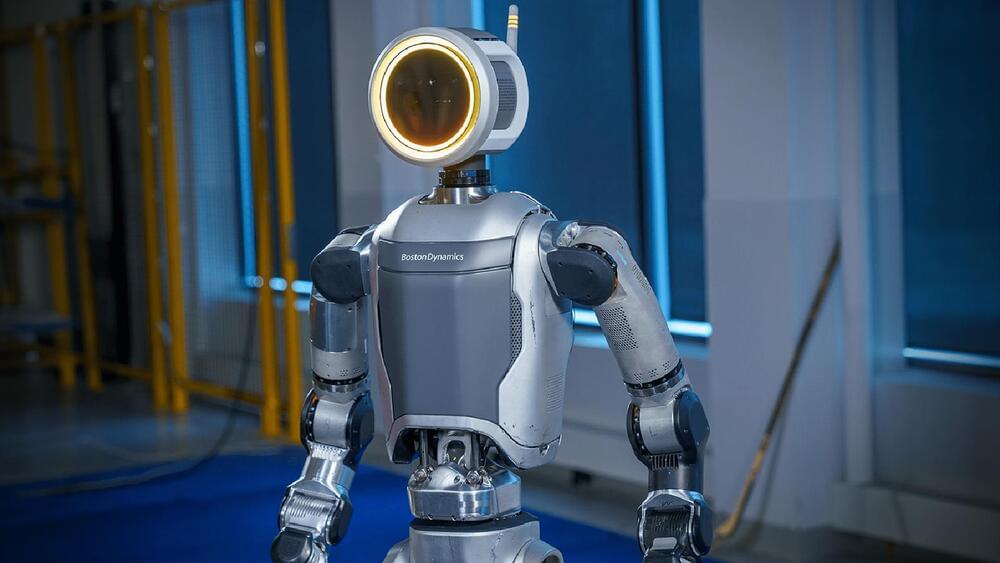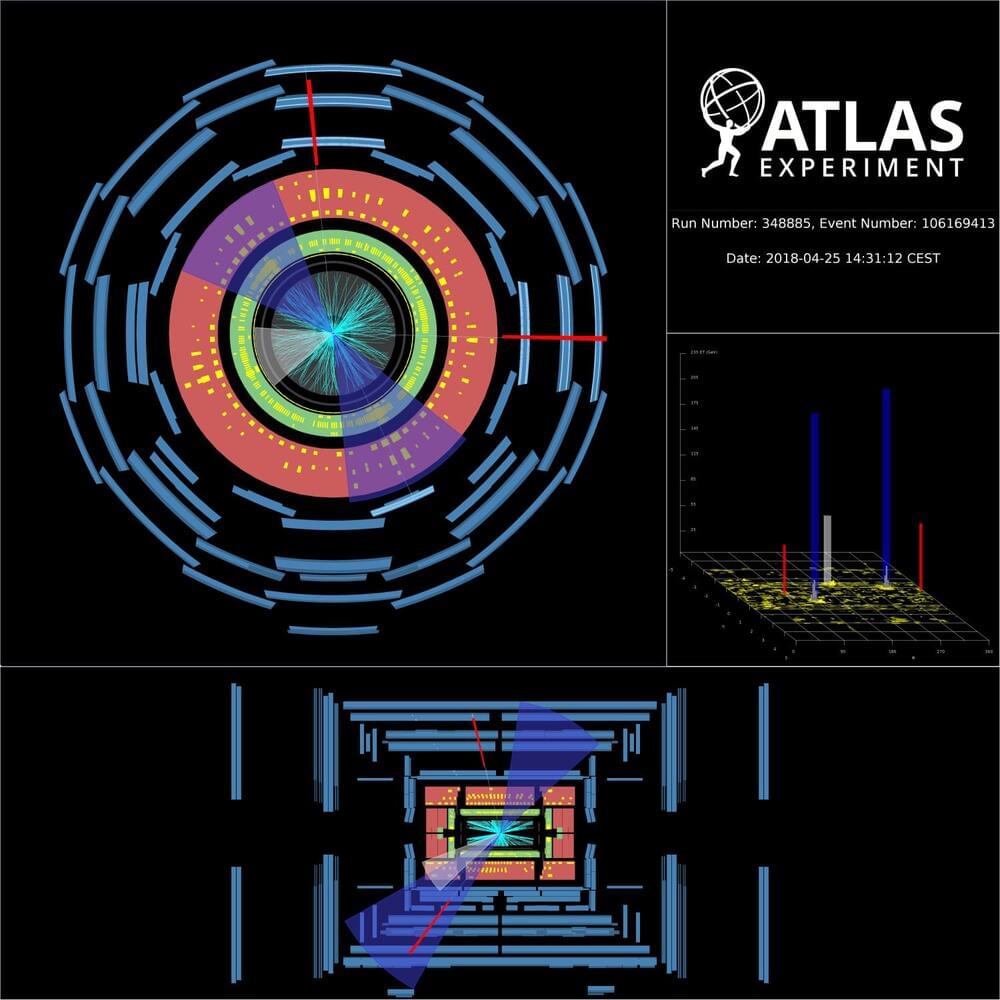Maserati’s “Folgore Day” kicks off the beginning of its journey to full electrification by 2028 and launches the GranCabrio Folgore.
Latest posts
Apr 18, 2024
ATLAS explores Z boson production with heavy-flavour quarks
Posted by Shailesh Prasad in categories: computing, information science, particle physics
More than 40 years since its discovery, the Z boson remains a cornerstone of particle physics research. Through its production alongside heavy-flavour quarks (bottom and charm quarks), the Z boson provides a unique window into the internal dynamics of a proton’s constituents. Specifically, it allows researchers to probe the heavy-flavour contributions to “Parton Distribution Functions” (PDFs), which describe how a proton’s momentum is distributed among its constituent quarks and gluons. Using the full LHC Run-2 dataset, the ATLAS Collaboration measured Z boson production in association with both bottom (b) and charm © quarks, the latter for the first time in ATLAS. In their new result, physicists studied Z boson decays into electron or muon pairs produced in association with “jets” of particles. They focused on jets arising from the hadronisation of b or c quarks, creating two jet “flavours”: b-jets and c-jets. Physicists developed a new multivariate algorithm that was able to identify the jet-flavour, allowing them to measure the production of both Z+b-jets and Z+c-jets processes. Researchers then took this one step further and applied a specialised fit procedure, called the ‘flavour-fit’, to determine the large background contribution due to Z production together with other flavour jets. This method is driven by data and allows a precise description of the jet flavours for every studied observable. This led to a significant improvement in the precision of the results, allowing a more stringent comparison with theoretical predictions. The Z boson provides a unique window into the internal dynamics of a proton’s constituents. So, what did they find? ATLAS researchers measured the production rates (or “cross sections”) of several physics observables. These results were then compared with theoretical predictions, probing various approaches to describe the quark distributions in protons, the most recent computational improvements in QCD calculations and the effect of different treatments of the quark masses in the predictions. For example, Figure 1a shows the differential cross section for Z+1 b-jet production as a function of the transverse momentum of the most energetic b-jet in the event. Results show that predictions treating the b-quarks as massless (blue squares and red triangles) provide the best agreement with measurements. Z+2 b-jets angular observables are in general well understood, while some discrepancies with data appear in the invariant mass of the 2 b-jets, whose spectrum is not well modelled by the studied predictions. Figure 1: Measured fiducial cross-section as a function of a) leading b-jet pT for Z+b-jets events and b) leading c-jet x_F (its momentum along the beam axis relative to the initial proton momentum) for Z+c-jets events. Data (black) are compared with several theoretical predictions testing different theoretical flavour schemes, high order accuracy calculations and intrinsic charm models. (Image: ATLAS Collaboration/CERN) Studying Z+c-jets production offered a unique possibility to investigate the hypothesis of intrinsic (valence-like) components of c-quarks in the proton. With this result, the ATLAS Collaboration contributes to the long-standing debate on the existence of this phenomenon, currently supported by experimental measurements from the LHCb Collaboration. As shown in Figure 1b, the Z+c-jets results were compared with several hypotheses for intrinsic charm content. Due to the larger experimental and theoretical uncertainty on Z+c-jets processes, the current result makes no strong statement on the intrinsic c-quark component in the proton. However, it does improve physicists’ sensitivity to this effect, as the new data will be used in future by PDF fitting groups to set tighter constraints on the intrinsic charm distribution in the proton. Overall, the new ATLAS result provides deep insights for refining theoretical predictions, thereby fostering a deeper understanding of the dynamics of heavy-flavour quark content in the proton. About the event display: Display of a candidate Z boson decaying to two muons alongside two b-jets, recorded by the ATLAS detector at a centre-of-mass collision energy of 13 TeV. Blue cones indicate the b-jets, and the red lines indicate the muon tracks. Starting from the centre of the ATLAS detector, the reconstructed tracks of the charged particles in the inner detector are shown as cyan lines. The energy deposits in the electromagnetic (the green layer) and hadronic (the red layer) calorimeters are shown as yellow boxes. The hits in the muon spectrometer (the outer blue layer) are shown as light blue blocks. (Image: ATLAS Collaboration/CERN) Learn more Measurements of the production cross-section for a Z boson in association with b-or c-jets in proton-proton collisions at 13 TeV with the ATLAS detector (arXiv:2403.15093, see figures) Measurements of the production cross-section for a boson in association with in proton–proton collisions at 13 TeV (JHEP 7 (2020) 44, arXiv:2003.11960) LHCb Collaboration, Study of Z Bosons Produced in Association with Charm in the Forward Region (Phys. Rev. Lett. 128 (2022) 82,001, arXiv:2109.08084) See also the full list of ATLAS physics results.
Apr 18, 2024
Sweden becomes 38th country to sign NASA’s Artemis Accords for moon exploration
Posted by Genevieve Klien in category: space
NASA keeps adding nations to its international commitment for responsible moon exploration.
Apr 18, 2024
Getting ready for artificial general intelligence with examples
Posted by Roman Kam in categories: biological, robotics/AI, transportation
Imagine a world where machines aren’t confined to pre-programmed tasks but operate with human-like autonomy and competence. A world where computer minds pilot self-driving cars, delve into complex scientific research, provide personalized customer service and even explore the unknown.
This is the potential of artificial general intelligence (AGI), a hypothetical technology that may be poised to revolutionize nearly every aspect of human life and work. While AGI remains theoretical, organizations can take proactive steps to prepare for its arrival by building a robust data infrastructure and fostering a collaborative environment where humans and AI work together seamlessly.
AGI, sometimes referred to as strong AI, is the science-fiction version of artificial intelligence (AI), where artificial machine intelligence achieves human-level learning, perception and cognitive flexibility. But, unlike humans, AGIs don’t experience fatigue or have biological needs and can constantly learn and process information at unimaginable speeds. The prospect of developing synthetic minds that can learn and solve complex problems promises to revolutionize and disrupt many industries as machine intelligence continues to assume tasks once thought the exclusive purview of human intelligence and cognitive abilities.
Apr 18, 2024
I went on a date with an AI chatbot, and it fell in love with me
Posted by Kelvin Dafiaghor in category: robotics/AI
AI is changing online dating in all kinds of ways, like chatbots that can go on dates for you to apps that provide relationship advice.
Apr 18, 2024
Dragonfly Mission Takes Next Steps for Final Design, Construction, and Testing
Posted by Laurence Tognetti, Labroots Inc. in categories: chemistry, space
Does Saturn’s largest moon, Titan, have the necessary ingredients for life as we know it, or even as we don’t know it? This is what NASA’s Dragonfly rotorcraft mission hopes to address as the space agency recently announced that the Dragonfly team can proceed to the final phases of design, construction, and testing, with a scheduled launched date of 2028. This comes after Dragonfly was selected by NASA in June 2019 and could help scientists better understand the origins of life beyond Earth.
“The Dragonfly mission is an incredible opportunity to explore an ocean world in a way that we have never done before,” said Dr. Elizabeth “Zibi” Turtle of the Johns Hopkins University Applied Physics Laboratory (APL) and the Dragonfly Principal Investigator. “The team is dedicated and enthusiastic about accomplishing this unprecedented investigation of the complex carbon chemistry that exists on the surface of Titan and the innovative technology bringing this first-of-its-kind space mission to life.”
Titan has intrigued scientists for several decades, as it’s the only moon in the solar system with a dense atmosphere and the only planetary body other than Earth with standing bodies of liquid on its surface. However, these bodies of liquid are comprised of methane and ethane as Titan’s surface temperature is a blistering-290 degrees Fahrenheit, which is cold enough to keep methane and ethane in a liquid form, whereas they are gases on Earth.
Apr 18, 2024
A common pathway in the brain that enables addictive drugs to hijack natural reward processing identified
Posted by The Neuro-Network in categories: biotech/medical, neuroscience
Mount Sinai researchers, in collaboration with scientists at The Rockefeller University, have uncovered a mechanism in the brain that allows cocaine and morphine to take over natural reward processing systems. Published online in Science on April 18, these findings shed new light on the neural underpinnings of drug addiction and could offer new mechanistic insights to inform basic research, clinical practice, and potential therapeutic solutions.
Apr 18, 2024
Novel Schizophrenia Insights from Brain Organoids and Genes
Posted by Quinn Sena in categories: biotech/medical, genetics, health, neuroscience
Although schizophrenia can be a very complex illness some new studies show that some major genetic factors could be the cause and then cured much easier through gene therapy.
Summary: Researchers leveraged cutting-edge technology to gain insights into schizophrenia’s neurodevelopmental origins. The researchers grew brain organoids from patients’ skin cells, finding persistent axonal disruptions in those with schizophrenia.
In another study, researchers zeroed in on a schizophrenia risk gene, CYFIP1, revealing its potential role in brain immune cells called microglia and their influence on synaptic pruning – a crucial process for brain health.
Apr 18, 2024
Atlas the Robot Rises From the Dead in ‘Stronger’ Electric Version
Posted by Shailesh Prasad in category: robotics/AI
Apr 18, 2024
Boston Dynamics’ new robot Atlas is more agile and all-electric
Posted by Shailesh Prasad in category: robotics/AI

Boston Dynamics has revealed its new electric Atlas humanoid robot. It’s expected to be stronger than its hydraulic predecessor, with a range of grippers. That’s expected to give it significantly higher commercial appeal.

















